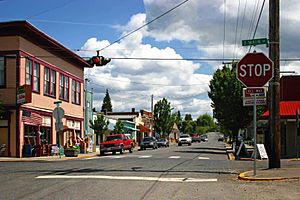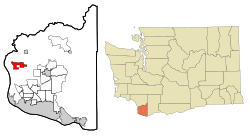Ridgefield, Washington facts for kids
Quick facts for kids
Ridgefield, Washington
|
|
|---|---|

Downtown Ridgefield, 2006
|
|

Location of Ridgefield, Washington
|
|
| Country | United States |
| State | Washington |
| County | Clark |
| Founded | 1909 |
| Incorporated | August 26, 1909 |
| Government | |
| • Type | Council–manager |
| Area | |
| • Total | 7.477 sq mi (19.365 km2) |
| • Land | 7.402 sq mi (19.171 km2) |
| • Water | 0.075 sq mi (0.193 km2) |
| Elevation | 259 ft (79 m) |
| Population
(2020)
|
|
| • Total | 10,319 |
| • Estimate
(2023)
|
15,027 |
| • Density | 2,030/sq mi (783.9/km2) |
| Time zone | UTC–8 (Pacific (PST)) |
| • Summer (DST) | UTC–7 (PDT) |
| ZIP Code |
98642
|
| Area code(s) | 360 and 564 |
| FIPS code | 53-58410 |
| GNIS feature ID | 2410945 |
Ridgefield is a city in northern Clark County, Washington, United States. In 2020, about 10,319 people lived there. By 2023, the population grew to an estimated 15,027 people.
Ridgefield is part of the Portland area. It is known for its strong connection to Native American history. The famous Lewis and Clark Expedition also passed through this area.
The city is home to the Ridgefield National Wildlife Refuge. This refuge is a special place for waterfowl (birds like ducks and geese) that migrate along the Pacific Flyway. Ridgefield is also where the Ridgefield High School "Spudders" are located. The name "Spudders" comes from the area's history of potato farming.
Contents
History of Ridgefield
The land around Ridgefield has important ties to the Lewis and Clark Expedition (1804–1806). It was near Cathlapotle, a large Chinookan town. This town had 700 to 800 people and many long plank houses.
To remember the Chinookan people, a replica of a Cathlapotle plank house was built. It is located at the nearby Ridgefield National Wildlife Refuge. This replica was officially opened on March 29, 2005.
The town was first called Union Ridge. This name was chosen by many soldiers who fought for the Union in the Civil War. They were among the first settlers after the war. In 1890, the town's name was changed to Ridgefield. The original name lives on in Union Ridge Elementary School.
Ridgefield became an important trading center early on. This was because of its key location near the mouth of the Columbia River. The city officially became a city on August 26, 1909.
Geography and Parks
The city of Ridgefield covers about 7.477 square miles (19.365 square kilometers). Most of this area is land, with a small part being water.
Ridgefield has several parks for people to enjoy. These include Abrams Park, Community Park, Davis Park, and Overlook Park. The Ridgefield Veterans Memorial is next to Community Park.
Economy and Businesses
The well-known rental and storage company U-Haul started in Ridgefield. It was founded here in 1945.
People of Ridgefield
| Historical population | |||
|---|---|---|---|
| Census | Pop. | %± | |
| 1910 | 297 | — | |
| 1920 | 620 | 108.8% | |
| 1930 | 607 | −2.1% | |
| 1940 | 643 | 5.9% | |
| 1950 | 762 | 18.5% | |
| 1960 | 823 | 8.0% | |
| 1970 | 1,004 | 22.0% | |
| 1980 | 1,062 | 5.8% | |
| 1990 | 1,297 | 22.1% | |
| 2000 | 2,147 | 65.5% | |
| 2010 | 4,763 | 121.8% | |
| 2020 | 10,319 | 116.6% | |
| 2023 (est.) | 15,027 | 215.5% | |
| U.S. Decennial Census 2020 Census |
|||
Population in 2020
In 2020, Ridgefield had 10,319 people living in 3,432 households. About 2,784 of these were families. The city had about 1,405 people per square mile.
Most people in Ridgefield were White (81.5%). Other groups included African American (1.0%), Native American (0.7%), and Asian (3.5%). About 8.1% of the population was Hispanic or Latino.
About 30.7% of residents were under 18 years old. About 12.2% were 65 years or older. In 2021, the average household income was $107,861 per year.
Education in Ridgefield
The Ridgefield School District serves the city's students. It has five schools:
- Union Ridge Elementary
- South Ridge Elementary
- Sunset Ridge Intermediate School
- View Ridge Middle School
- Ridgefield High School
Notable People from Ridgefield
- Scott Mosier: A film producer and podcaster.
- Richie Sexson: A former professional baseball player.
- Leonard Shoen: The person who founded U-Haul in Ridgefield.
See also
 In Spanish: Ridgefield (Washington) para niños
In Spanish: Ridgefield (Washington) para niños

